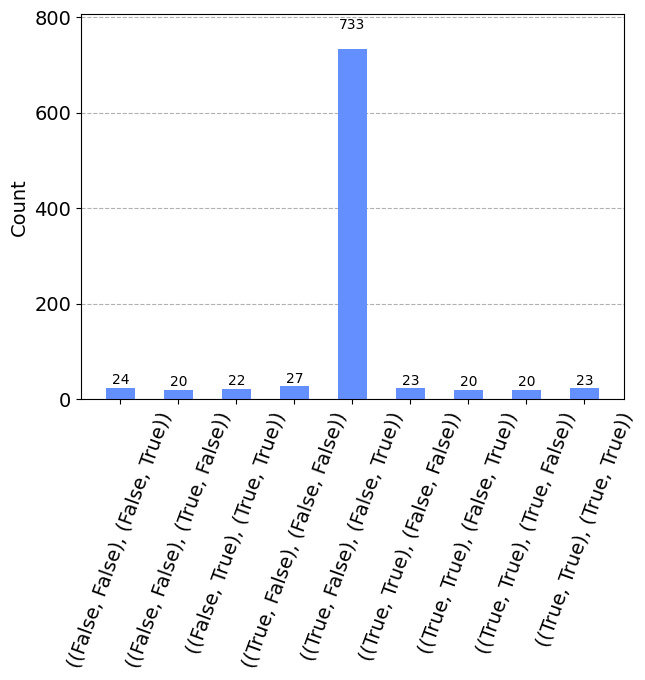Quantum Computing on Arduino
Today, I’m going to show you how to use Qlasskit to create a quantum circuit able to search for Sudoku puzzle solutions.
Qlasskit, is an open-source Python library developed with the support of a Unitary Fund microgrant, addresses this challenge head-on by allowing direct translation of standard Python code into invertible quantum circuits without any modification to the original code.
Using qlasskit for this use case, will allow us to write and execute a quantum circuit, writing only python code without any quantum related primitives.
Since current quantum computers are very limited machines, we cannot solve a real 9x9 sudoku puzzle; our
toy examples uses a 2x2 matrix where a valid solution is when in every row and every column there are no
repeated values (0 or 1). We encode these xor-ing the values for each row and column.
Since we want a specific solution, we add a constraint constr: we want the [0][0] element to be True.
from qlasskit import qlassf, Qmatrix
from qlasskit.algorithms import Grover
@qlassf
def sudoku_check(m: Qmatrix[bool, 2, 2]) -> bool:
constr = m[0][0]
sub0 = m[0][0] ^ m[0][1]
sub1 = m[1][0] ^ m[1][1]
sub2 = m[0][0] ^ m[1][0]
sub3 = m[0][1] ^ m[1][1]
return sub0 and sub1 and sub2 and sub3 and constr
Now that we have an oracle, we can instantiate the Grover search algorithm:
q_algo = Grover(sudoku_check)
Then we use our prefered framework and simulator for sampling the result; this is an example using qiskit with aer_simulator.
We obtain that the solution for this puzzle is the matrix [[True, False], [False, True]].
from qiskit import Aer, QuantumCircuit, transpile
from qiskit.visualization import plot_histogram
qc = q_algo.export("qiskit")
qc.measure_all()
simulator = Aer.get_backend("aer_simulator")
circ = transpile(qc, simulator)
result = simulator.run(circ).result()
counts = result.get_counts(circ)
counts_readable = q_algo.decode_counts(counts, discard_lower=20)
plot_histogram(counts_readable)

We can exploit matplotlib for drawing the result sudoku matrix as follows:
import matplotlib.pyplot as plt
def draw_matrix(matrix):
fig, ax = plt.subplots()
ax.matshow(matrix, cmap='viridis')
for i in range(len(matrix)):
for j in range(len(matrix[0])):
ax.text(j, i, str(matrix[i][j]), va='center', ha='center', fontsize=12, color='black')
plt.show()
m_res = list(filter(lambda x: x[1] > 500, counts_readable.items()))[0][0]
draw_matrix(m_res)

We can create a more realistic sudoku game using numbers instead of booleans, but the resources required will scale exponentially. In the following code snippets, we recreate sudoku_check using Qint2 and a 4x4 matrix. The sum of each column and row must be equal to 6 (3+2+1+0). As we can see, the resulting circuit of the checker requires more than 100 qubits, way above our simulation capabilities.
from qlasskit import Qint2, Qint4
@qlassf
def sudoku_check(m: Qmatrix[Qint2, 4, 4]) -> bool:
res = True
# Constraints
res = (m[0][2] == 3) and (m[0][0] == 1)
# Check every row and column
for i in range(4):
c = (Qint4(0) + m[i][0] + m[i][1] + m[i][2] + m[i][3]) == 6
r = (Qint4(0) + m[0][i] + m[1][i] + m[2][i] + m[3][i]) == 6
res = res and c and r
return res
print(sudoku_check.circuit())
QCircuit<sudoku_check>(1309 gates, 178 qubits)
Useful Links:
During my Quantum Computing journey, I often needed to simulate some quantum circuits; sometimes they are small, but some other times they are bigger enough ...
Despite it is sold as a non-cartographic handled GPS device, with limited storage capacity of 10 MB and the inability to expand it, the eTrex 10 GPS, like al...
Since the latest v0.1.18 version, the Qlasskit library offers two useful tool for circuit analysis and optimization.
In the last release of Qlasskit, I introduced a new feature able to export a qlassf function to a binary quadratic model (as bqm, qubo or ising model). This...
In early 2023, I embarked on a journey to explore the field of probabilistic computing. This endeavor culminated in the construction of a hardware prototype,...
Today, I’m going to show you how to use Qlasskit to create a quantum circuit able to search for Sudoku puzzle solutions.
In a recent article I wrote, “Quantum Computing on a Commodore 64 in 200 Lines of BASIC”, published both on Medium and Hackaday.com, shows a two-qubit quantu...
Traditionally, creating quantum circuits requires specialized knowledge in quantum programming. This requirement holds true when encoding a classical algorit...
In an age where companies are selling two-qubit quantum computers for a sum of money that would make your wallet recoil in horror, here we are, stepping off ...
This June I emerged as one of the top participants with 9 bounties collected (alongside another exceptional contributor) in the #UnitaryHack Hackathon, hoste...
A few days ago I came across a yt video discussing the ESA Copernicus program, a European initiative for monitoring earth via a satellite constellation. This...
Qiskit is a python SDK developed by IBM and allows everyone to create quantum circuits, simulate them locally and also run the quantum circuit on a real quan...
As someone noticed from the previous post, last weeks I started to write a new programming language for Tezos smart contracts. This project was initially int...
While writing a new programming language, it is often useful to write some real use-cases to test the syntax, the language expressiveness and the code cleann...
Documentation is like sex: when it is good, it is very, very good; and when it is bad, it is better than nothing
This is my new blog, based on jekyll. I’ll soon import old posts from my old blog.
Contractvm is a general-purpose decentralized framework based on blockchain. The framework allows to implement arbitrary decentralized applications in an eas...
Most of bitcoin dice software use a system to prove the fair play of the server for each bet. Most of them implement this mechanism using two seed (server se...
In the aim to merge two of my server on digitalocean, today I tried to write a mod_rewrite rule to redirect a secondary domain to a subfolder. After one hour...
MineML is a multithread CPU based bitcoin miner written in F#. At the moment it’s a slow implementation, but the class structure offers the possibility to im...